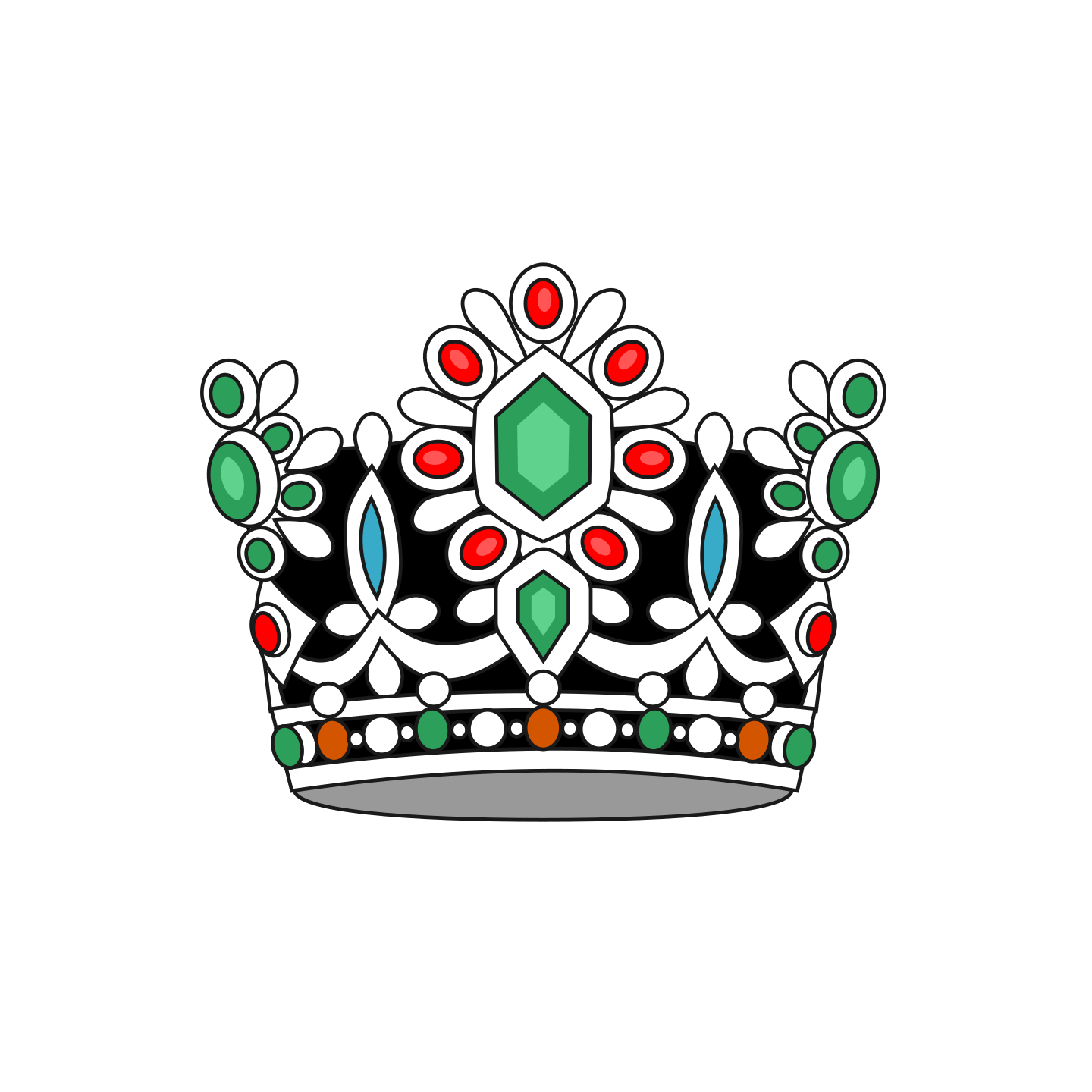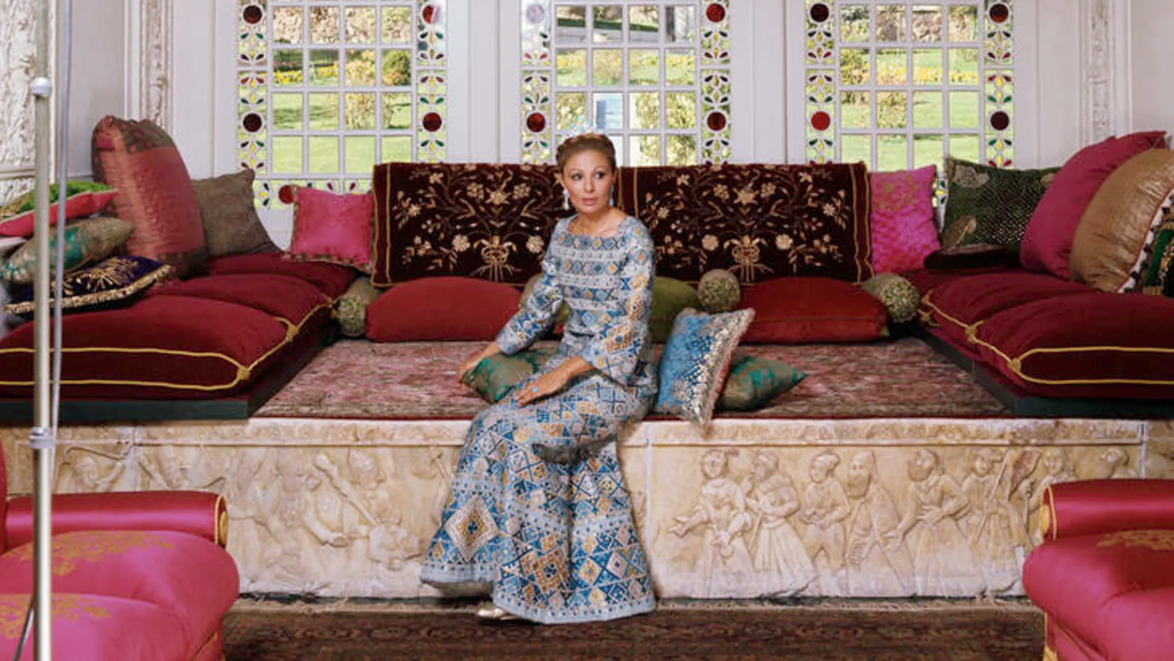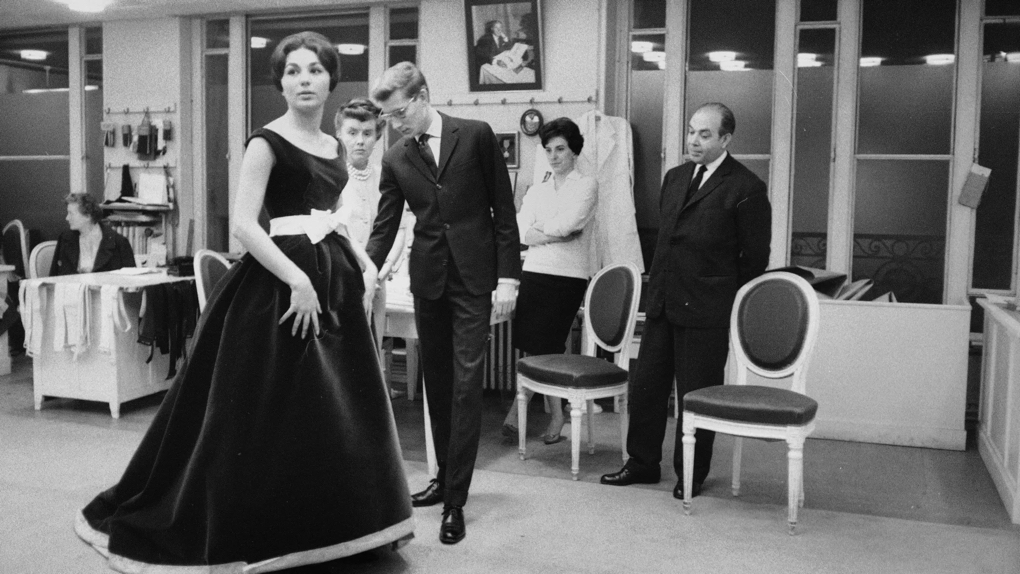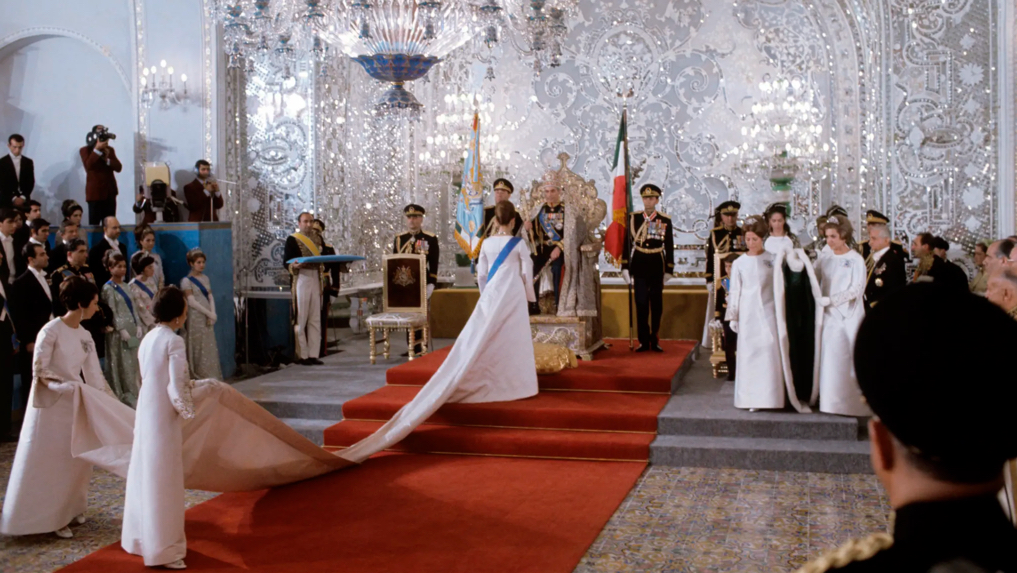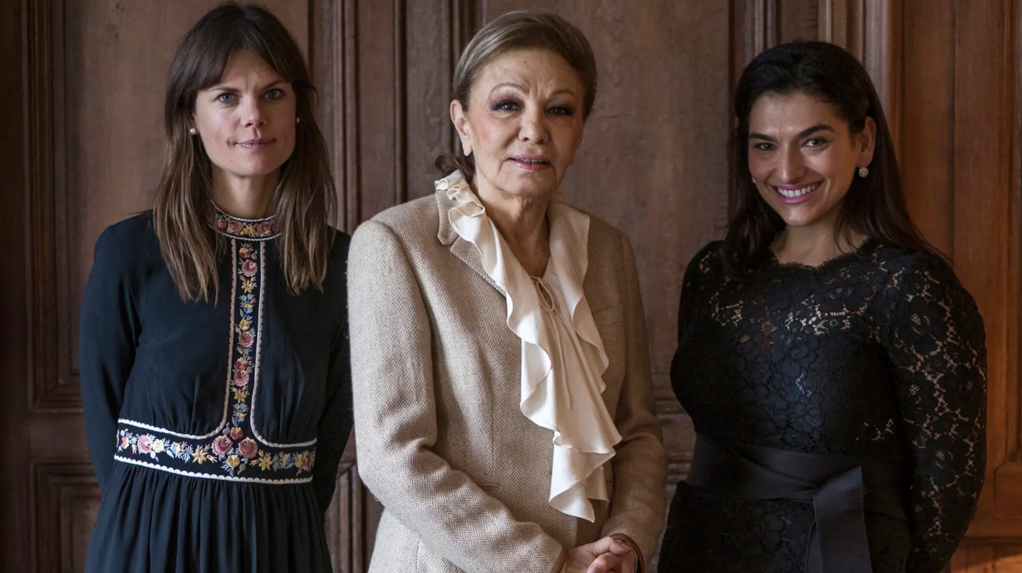How an Empress transformed Iran with art
Dubbed “the Jackie Kennedy of the Middle East”, Farah Pahlavi built a world-class collection of modern art before she and her husband were exiled. Now 80, she reflects on her beloved country.
Those were the days when VIPs would draw up in low-slung limousines to hear her speak: Henry Kissinger, Lady Bird Johnson, Nelson Rockefeller. That was an era when she counted triple-A celebrities among her friends and acquaintances: Elizabeth Taylor, Yves Saint Laurent, Andy Warhol. It was also a tumultuous, pre-revolutionary age when rival demonstrators thousands of kilometers away from Iran exchanged angry chants in the shadows of the skyscrapers: “Long live her majesty!” versus “Down with the Shah!” Now, though, visits from a former queen once dubbed “the Jackie Kennedy of the Middle East” go largely unnoticed. In early October, when I arrive at the luxury apartment building on the Upper West Side where she’s due to attend a late-afternoon reception, the doorman on duty looks at me bemusedly when I tell him I’m here to see “the Empress of Iran”
Farah Pahlavi was the first woman in the country’s 2500-year history to be bestowed with that title. She was adored, almost worshipped by many of her late husband’s subjects. But though the cheery woman who walks into the lobby still gives off a bright-eyed royal radiance, absent are any regal airs and graces. No longer is she trailed by men in dark suits mumbling into their sleeves, a far cry from the days when royal coaches paraded through the streets of Tehran flanked by a mounted guard of spear-carrying horsemen.
Nor is she extravagantly dressed. Pahlavi is wearing a thigh-length woven paisley jacket and camel trousers, her tawny hair gathered up in a bow, an unfussy outfit for a queen who in her palace heyday wore glamorous showstoppers by Givenchy, Dior, and Valentino.
Upstairs at the reception, when an Iranian-American plastic surgeon approaches Pahlavi hesitantly, bowing his head in genuflection and then bending down to kiss her hand, she looks somewhat taken aback. Minutes later they are laughing, joking, and reminiscing about their homeland with almost backslapping bonhomie. Turns out the doctor trained in Shiraz at what was then called Pahlavi University, an institution she helped found and the first in Iran to be based on the American model. His entire medical degree costs just a hundred bucks, he tells her to uproarious laughter, and thus he owes her an enormous debt.
Watching her humbly work the room, happily posing for photos – nobody asks Her Majesty for a selfie – one wonders how this genial grandmother could ever have been placed on a revolutionary death list. Then you sense this infectious charm, this natural empathy, this ease among her followers, was precisely the reason why. On the eve of her 80th birthday, Pahlavi is here to celebrate the publication of a new book. The power she once projected peers out from its cover: an iconographic portrait of her from the mid-1970s, taken through the lens of Andy Warhol’s Polaroid Big Shot camera. Iran Modern: The Empress of Art tells the story of one of the 20th century’s more unlikely cultural brokers, a woman who amassed the greatest collection of Western modern art anywhere outside of the US or Europe, starting with the Impressionists and ending with what were then contemporary greats such as Jackson Pollock.
“It’s beautiful, it’s fabulous, it’s a work of art in itself,” she says of this handcrafted limited-edition book that comes in a canary-yellow clamshell case. But inside is a story of exile, loss, and heartbreak, of artistic triumph and tragedy. Once you learn the backstory, Warhol’s silk-screen rendering takes on a different meaning. One notices not just her charismatic dominion but also the sorrow in those kohl-rimmed eyes.
As a child, she developed a love of art from leafing through the sketchbooks of her paternal grandfather, a good drawer who kept art journals, and on leaving school she went to Paris to study at the prestigious École Spéciale d’Architecture. Invited to a reception at the Iranian Embassy in 1959, she was introduced to Mohammad Reza Pahlavi, who had first been crowned the Shah of Iran in 1941 and returned to power in 1953 following a CIA–backed coup. What were her first impressions? “He had beautiful eyes but sad eyes.” Why were they sad? “For his life. The pressure on him.” They provided a window on her future.
A courtship developed when she returned to Tehran for the summer. They were married in December 1959 in a ceremony at Tehran’s Marble Palace, where she wore a gown by Yves Saint Laurent and a two-kilogram tiara designed by jeweler to the stars Harry Winston. In keeping with Persian tradition, the bride remained silent when twice asked if she wanted to marry the Shah. Asked a final time, she said yes. Farah became his third wife. The first two had failed to provide him with a male heir. Ten months later she gave birth to a son, Crown Prince Reza, the first of the couple’s four children. The Shah was 40, she almost half his age and her new role were overwhelming. “As a 21-year-old girl, I didn’t know what to do,” she recalls. “When the Shah asked me to marry him, he said, ‘As a queen, you will have a lot of responsibilities.’ I said, ‘Of course,’ but I couldn’t imagine the scale of it.”
In those early years, she was more Princess Diana than Jackie Kennedy. Visiting Iran’s impoverished towns and villages. Reaching out her royal hand to the needy. Setting up a community for lepers, leading blood drives, and creating mobile libraries – these were sometimes mules that ferried books into the mountains. “In those days, my most important work was with the children, with the orphans, with the lepers,” she recalls. “I was traveling all over Iran, seeing what needed to be done.” It’s the stuff of a Queen of Hearts fable, but it also happens to be true.
In 1963, her husband launched the White Revolution, a reform program intended to bring modernity to the ancient kingdom, and also to lend his reign more legitimacy in the eyes of the peasantry. “Iran was going ahead in every way,” she says. “In the economy, industry, education, our relations with the rest of the world, in everything. Many dreams came true during that period.” Women’s rights were also given a boost in a 1963 referendum that ushered in female enfranchisement, and family protection laws that allowed wives to obtain divorces raised the minimum age of marriage to 18 and granted mothers new custody rights. The Shiite clergy fiercely opposed this liberalization program, pushed through with the iron fist of the regime, and a cleric by the name of Ayatollah Ruhollah Khomeini became the figurehead of protests. Khomeini was exiled in 1964, but his insurgent followers were not so easily banished.
In 1967, partly to honor the women of Iran, the Shah elevated the status of his wife; a highly unusual move for a Muslim monarchy. In another opulent ceremony, in the Hall of Mirrors in Tehran’s Golestan Palace, Farah was crowned the Empress of Iran, or Shahbanu, the Shah’s consort. For the coronation ceremony, she wore a long white satin Dior dress; the emblem of Iran was embroidered in gold into the cape. In further promotion, she became the first woman to be named the Shah’s regent. It meant that if her husband died before their son, Crown Prince Reza, reached adulthood, she would take the throne until his 21st birthday.
No Iranian woman had ever occupied such an exalted position. To outsiders, it might even have looked like the flowering of women’s liberation in the Middle East. But the Shah could also be chauvinistic. In a televised cabinet meeting, he condescendingly scolded his wife for suggesting he promote more music across the land. “Why is this my concern?” he snapped as if dismissing some lowly courtier. His misogyny also came to the fore in a 1973 interview with the Italian journalist Oriana Fallaci.
“Women count only if they are beautiful, graceful, and know-how to stay feminine,” he declared, like some medieval potentate. “You may be equal in the eye of the law, but not inability … You have never produced a Michelangelo or a Bach. You’ve never even produced a great cook … You’re schemers. You’re evil. Every one of you.”
When the trailblazing American TV presenter Barbara Walters challenged the Shah about these comments in a prime-time interview in 1977, it made for excruciating viewing. “Do you think a woman could govern as well as a man?” probed Walters. There followed the most awkward of prolonged silences, a television eternity in which he visibly shriveled before the camera. Eventually, the shell-shocked Shah muttered: “I’d prefer not to answer that.” Then Walters turned to the Empress. “Say something, Your Majesty,” she implored. There was a gaping pause, and a frozen half-smile. “What can I say?” was her pained response.
I ask Pahlavi if her husband was really a modern man. “Very modern, very kind, really polite, with everybody,” she replies, with such a show of loyalty that it feels cruel to pose a Walters-style follow-up. As the staunchest defender of her husband’s memory, what can she say?
Then there were the museums she created: to house Persian carpets, per-Islamic ceramics, 19th-century Iranian paintings, Luristan bronzes and, what would become her crowning achievement, the Tehran Museum of Contemporary Art. Originally, the museum was intended as a showcase for Iranian artists, but with the Shah’s regime awash with cash following the doubling of oil prices in 1973, Pahlavi’s artistic ambitions ballooned. Why not also make it the home to some of the world’s greatest modern and contemporary works, pieces she had long admired from afar? “It’s now or never to buy some of these things,” she told her husband, as she spearheaded a spending spree on the international art market, snapping up works by Wassily Kandinsky, Pablo Picasso, Mark Rothko, Paul Gauguin, Roy Lichtenstein, Joan Miró, Edvard Munch, Edward Hopper, René Magritte and Pierre-Auguste Renoir, a triptych by Francis Bacon and one of Jackson Pollock’s most celebrated drip-paintings, Mural on Indian Red Ground. (She also tried to acquire Pollock’s Blue Poles, but the National Gallery of Australia in Canberra, with the backing of PM Gough Whitlam, outbid her.)
As well as being a patron, she visited and befriended artists: Henry Moore, Salvador Dalí, Marc Chagall. At a White House gala thrown by US president Gerald Ford, she met Andy Warhol, although the pop artist tried to avoid her for much of the evening, hurriedly moving from one stately room to another, through fear she would ask him to dance. “He wondered why this woman was running after him,” she says, laughing. Eventually, she cornered him, and the conversation that followed persuaded Warhol to visit Iran in 1976. In between pool parties and caviar binges at the Tehran Intercontinental, Warhol took a portrait of the Empress that proved such a hit in the royal household that he returned to photograph the Shah.
Tehran’s Museum of Contemporary Art was inaugurated in 1977, with parkland once used by the military now dotted with sculptures by Henry Moore and Alberto Giacometti, and a Brutalist building dubbed an “underground Guggenheim” because of its spiral ramp that took visitors on a descent into its bowels. Here was hung what’s been called “the best modern art collection you have never heard of”: 200 or so works with a current-day value conservatively estimated at well over $US3 billion.
Less than two years later, the Shah was deposed in the Islamic Revolution, and the couple was forced into exile – in Egypt, Morocco, The Bahamas, Mexico and, briefly, the US, where President Jimmy Carter’s decision to allow the Shah to receive cancer treatment prompted the seizure of 52 American diplomats and staff at the US embassy in Tehran. “It was very, very hard to leave, especially when I saw the tears in the eyes of my husband,” Pahlavi remembers. “When you leave your land, your love, your belongings, it’s very sad. But I didn’t want to be negative. I didn’t want to lose my hope and positivity.” On the plane, as they jetted towards Egypt, she immediately began writing morale-boosting letters to friends and supporters left behind.
Did the museum contribute to their overthrow? Opened on Pahlavi’s 39th birthday, with her cousin as the principal architect, it could be construed as a landmark of the Pahlavis’ extravagance. “Not at all. Not at all. Not at all. Not at all,” she says, vehemently shaking her head. “There was no reaction to the museum. It was for Iranian art, not just foreign art.”
As Islamic revolutionaries swept through the streets, curators at the museum tried to hide the collection from the mob and succeeded in protecting most of it – although a Henry Moore bronze took a bullet. Years later, however, Pahlavi watched a French documentary that showed a Warhol portrait from her personal collection slashed with a knife. That must have been wounding. “I thought, ‘They’re stupid,’ ” she chortles. “If they’d have kept it, they could have sold it for a million dollars.”
With much of the gallery turned by the Ayatollah into a bunker-like vault, most of the collection was not seen for decades. In 1999 and 2005, some works were briefly put on display, long enough for photographers to capture Iranian women, shrouded in their hijabs, studying the abstract expressionist works. Long enough to have an impact. Afterward, some of the women who toured the gallery made contact with Pahlavi. “I had tears in my eyes when I stood in front of the Rothko,” emailed one. “It’s really very touching for me. The seeds you plant with love and belief, they never die.”
Two years ago, as relations thawed between the West and Tehran following the landmark nuclear deal negotiated by the Obama administration and the EU, works from the collection were due to go on display in Berlin and then Rome. At the 11th hour, however, the Iranian authorities pulled out. “They’re all the same,” Pahlavi says of Iran’s supposedly reform-minded leaders. “Before they were flogging people 200 times, now they are flogging people 45 times. Shall we say that’s good? It’s not.”
Pahlavi had planned to travel to Berlin from Paris, where she lives in an apartment overlooking the Seine decorated with contemporary Iranian artwork. Canceling the trip must surely have added to the agony of being divorced from the collection she’d lovingly put together. “I’m not separated, in a way,” she says. “With those works, yes, but I go to art galleries with Iranian artists, painters, and sculptors in Paris and New York. I listen to Persian music. So I’m in it. I’m not in Iran, but I am in it.”
Loss is a recurring theme in her life. Of her father. Of her husband, who in 1980 died of cancer in Egypt aged 60, 18 months after fleeing his homeland. Of her daughter, Princess Leila, who died from a drug overdose in London in 2001, aged 31. Of her second son, Prince Ali-Reza, who at 44 committed suicide in Boston in 2011. Of the country, she has never returned to. Of her art.
Does it sadden her that so few people get to cast eyes on the collection? “No. What is most important is what has happened to my country. It’s not just one museum, there are so many other things. As I always say, I never lose hope for Iran.” At least the new book, put together by two Australians, Sydney writer Miranda Darling and London-based art adviser Viola Raikhel-Bolot, will bring many of the works to a new audience. The duo is also filming a documentary on Pahlavi’s life. “We all experience loss in our lives,” says Darling, “but she’s lived it on an epic scale. This is what makes her cinematic and interesting. She was a visionary.
We talk about the hostility she encountered on earlier visits to New York City. “There were always people demonstrating against us, and they carried pictures of Khomeini and I was so astonished. I said, ‘My God, how come these people who shout for freedom and democracy have a portrait of a mullah?’
Those protests were so angry, I point out, partly because of the autocratic excesses of the Shah’s regime and the brutality of his hated secret police, the SAVAK, which used electric cattle-prods, acid, nail extractions, mock executions and even snakes to torture opponents. “I can’t deny that,” she says, nodding. “But my husband really did want to bring in democracy, but when people are not educated and not literate, it takes time.”
As the book party draws to a close, and many of the guests start heading for the door carrying signed copies of Iran Modern: The Empress of Art in specially designed tote bags, there’s an ear-piercing whistle. With a lusty blast from her lungs, and two fingers wedged into either side of her mouth, the Empress signals it is time to go. Around her assembles what’s more of a posse than an entourage: her young granddaughter, her daughter-in-law, and a few well-heeled Iranian friends. And with that, she steps out, anonymous again, into the rainy New York night.
Article by: By Nick Bryant
Source: The Sydney Morning Herald

